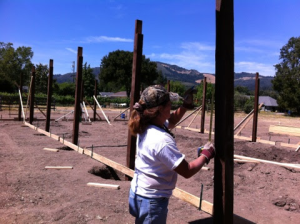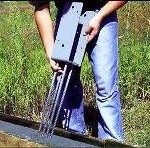DEAR POLE BARN GURU: I’m using 6″ x 6″ treated posts, do I need to use galvanized nails to attach my girts to the posts, do you recommend 20d galv ringshanks driven w a palm-nailer vs 3-1/4″ 16d non galv ringshanks I can shoot with gun? James in Golden, CO
DEAR GOLDEN: Any time nails are being used into pressure treated lumber, they should be galvanized or stainless steel. This is a code requirement.
With pole buildings, my personal preference is to always use galvanized nails. The few dollars saved with non-galvanized nails, is just not worth the rust streaks caused, in the event the building is rained upon before being closed in.
The size of nail is an entirely different subject.
If you are attempting to use 2x wall girts laid flat on the outside of the columns (what I would refer to as “barn” style), there is a good chance they will not meet code for deflection. And yes, a Building Permit may have been granted, but it does not mean the building actually meets the Code requirements.
Assuming the barn style wall girts do meet code, the critical load on the nails is for withdrawal – the wind forces are trying to suck the girts off from the building. In this case, the larger the diameter of the nail, the better it will be against these forces. I like using 10d common galvanized nails, as the .148 inch diameter is excellent against withdrawal, and I can drive them from my nail gun.
DEAR POLE BARN GURU: My roof cap is leaking and can’t find a closure strip think it was built in the 80’s can you help me? UNCLOSED CHRIS
DEAR UNCLOSED: What you are describing is sadly an all too common an occurrence.
Way back (in the ‘90s) when I was running as many as 35 building crews, in six states, our project coordinators visited every job, after it was completed, to verify it met our standards. One of the tools they carried along with them….binoculars, so they could see if the closures had been installed under the ridge caps! Although closures take next to no time to place, unless the crews knew they were going to be checked up on, they would leave them out.
More often than not, it now happens because builders, or building kit providers, are trying to lower their costs, and have cheaper selling prices than their competitors. When price becomes the driving focus of a purchase – there is always someone who is willing to leave more out, or sacrifice quality, to sell at a lower price. Until consumers experience problems like you are having (or worse), they rarely know or understand the difference.
Knowing the exact profile of the roof steel will help to determine if a form fitted outside closure strip is available. Some steel patterns were specific to manufacturers who are no longer in business. In that case, expandable closures are available which will seal the gap. Under no circumstances be tricked into purchasing a “universal” closure strip. While very affordable, they are made from open cell foam, which is closer to being a sponge than a closure. They are also not UV resistant and will deteriorate in a matter of very few years – recreating the original problem. Take a picture of the profile of your steel and look on the internet for closure strip companies to match the profile to the strips they have available. When in doubt, use an expandable closure. We used some on an old building we purchased, and although very sticky (so you have to be fast and clean your hands often) they did seal the gap so no more leaks!









